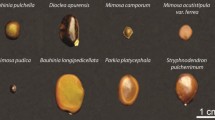Abstract
Seeds from 10 species were collected, sealed in fiberglass screen pouches, and stored under hardware-cloth cages on both a forest and cleared site for up to five years. At each site, half of the pouches were placed under leaf litter and the other half were planted in mineral soil. Liquidambar styraciflua and Callicarpa americana seeds had high germination rates under all conditions. Quercus falcata, Sassafras albidum, Rhus copallina, and Vaccinium arboreum required planting in mineral soil to ensure germination. Planted Myrica cerifera and Vitis aestivalis seeds germinated well on both sites. Myrica cerifera also germinated well if placed under litter on the forest floor and Vitis aestivalis if placed under litter on the cleared site. Germination of Crataegus uniflora seeds was erratic. Most Lonicera japonica were unsound when collected. Germination rates generally decreased over time, but some Sassafras albidum, Myrica cerifera, and Vaccinium arboreum seed germinated after four years, and Rhus coppalina, Callicarpa americana, Crataegus uniflora, and Vitis aestivalis seeds germinated after five years in the field.
Similar content being viewed by others
References
Bonner, F. T. 1974. Seed testing, pp. 136–152. In: Schopmeyer, C. S. (Tech. Coordinator) Seeds of woody plants in the United States. USDA, Washington, DC. Agric. Handbook No. 450.
Cain, M. D. and Mann, W. F.Jr. 1980. Annual brush control increases early growth of loblolly pine. South. J. Appl. For. 4: 67–70.
Conn, J. S., Cochrane, C. L. and DeLapp, J. A. 1984. Soil seed bank changes after forest clearing and agricultural use in Alaska. Weed Sci. 32: 343–347.
Deen, R. T. and Hodges, J. D. 1991. Oak regeneration in abandoned fields: presumed role of the blue jay. Proc. Bienn. South. Silvicultural Res. Conf. 6: 84–93.
Graber, R. E. and Thompson, D. F. 1978. Seeds in the organic layers and soil of four beech-birch-maple stands. USDA Forest Serv., Northeast. Forest Exp. Sta., Broomall, Pennsylvania. Res. Paper NE-401.
Halls, L. K. 1977. Southern fruit-producing woody plants used by wildlife. USDA Forest Serv., Southern Forest Exp. Sta., New Orleans, Louisiana, Gen. Tech. Report SO-16.
McCreary, D. and Koukoura, Z. 1990. The effects of collection date and pre-storage treatment on the germination of blue oak acorns. New For. 3: 303–310.
Reader, R. J. 1991. Control of seedling emergence by ground cover: a potential mechanism involving seed predation. Can. J. Bot. 69: 2084–2087.
Schiffman, P. M. and W. C.Johnson. 1992. Sparse buried seed bank in a southern Appalachian oak forest: implications for succession. Am. Midl. Nat. 127: 258–267.
Walstad, J. D. and Kuch, P. J. 1987. Forest vegetation management for conifer production. John Wiley & Sons Publishers, New York/Chichester/Brisbane/Toronto/Singapore. 523 p.
Wendel, G. W. 1977. Longevity of black cherry, wild grape, and sassafras seed in the forest floor. USDA Forest Serv., Northeast. Forest Exp. Sta., Broomall, Pennsylvania. Res. Paper NE-375.
Author information
Authors and Affiliations
Rights and permissions
About this article
Cite this article
Haywood, J.D. Seed viability of selected tree, shrub, and vine species stored in the field. New Forest 8, 143–154 (1994). https://doi.org/10.1007/BF00028190
Received:
Accepted:
Issue Date:
DOI: https://doi.org/10.1007/BF00028190
Key words
- Sweetgum (Liquidambar styraciflua L.)
- southern red oak (Quercus falcata Michx. var. falcata)
- sassafras (Sassafras albidum (Nutt.) Nees)
- American beautyberry (Callicarpa americana L.)
- oneflower hawthorn (Crataegus uniflora Muenchh.)
- southern bayberry (Myrica cerifera L.)
- shining sumac (Rhus copallina L.)
- tree sparkleberry (Vaccinium arboreum Marsh.)
- Japanese honeysuckle (Lonicera japonica Thunb.)
- summer grape (Vitis aestivalis Michx.)
- seed germination
- soil seed bank




